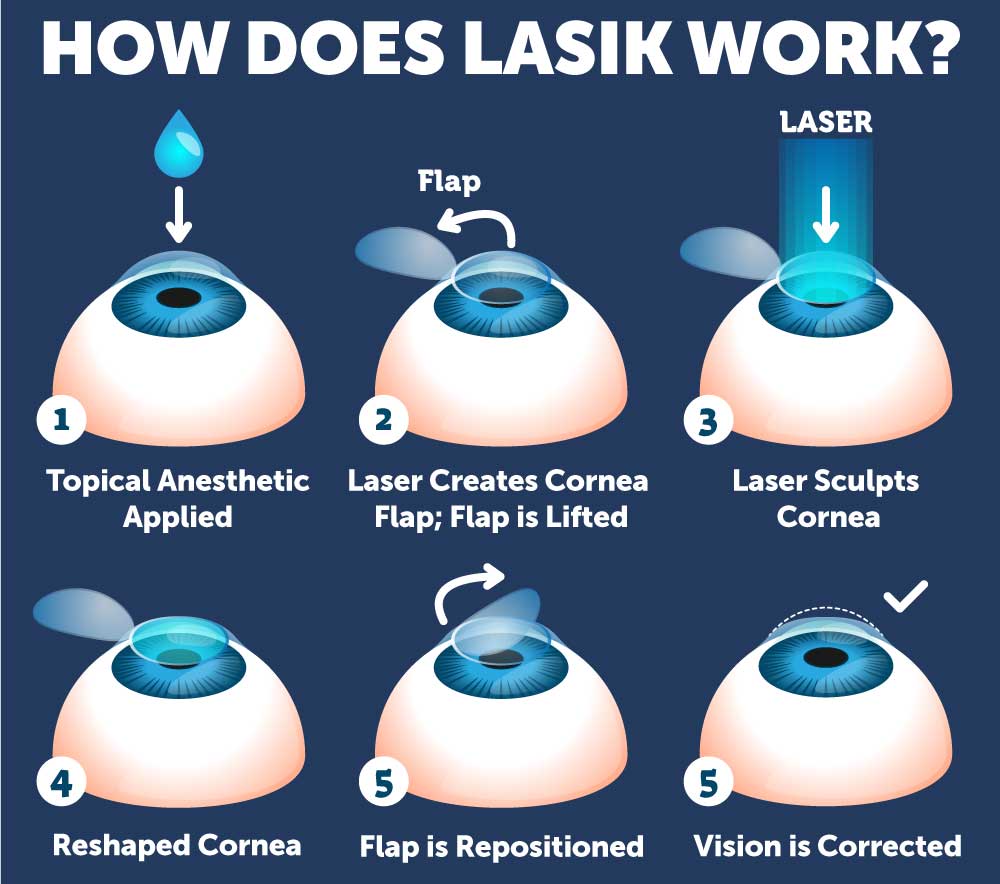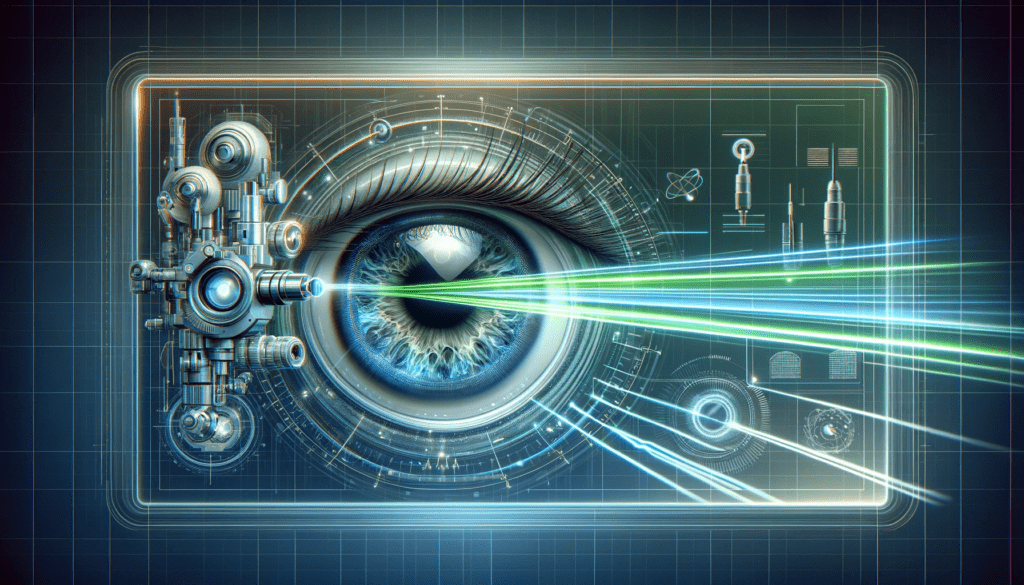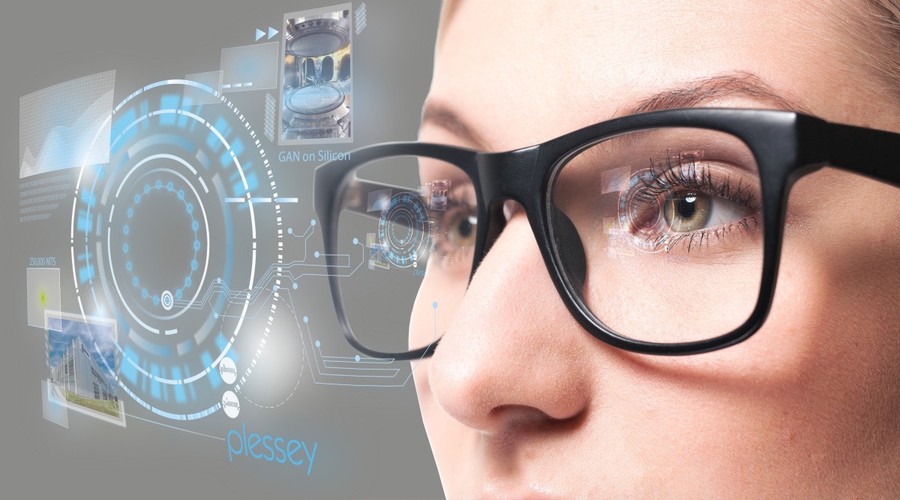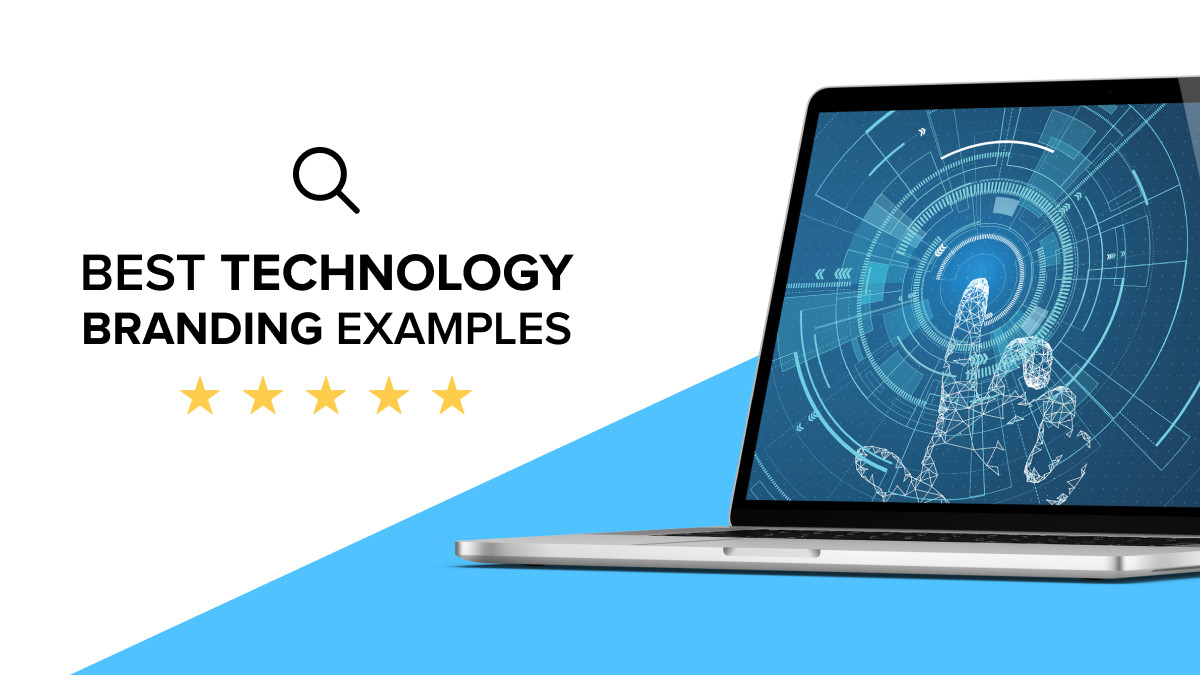New LASIK Technology: Revolutionizing Vision Correction
New LASIK technology has ushered in a new era of vision correction, offering patients unparalleled precision, safety, and personalized treatment options. LASIK, which stands for Laser-Assisted In Situ Keratomileusis, is […]
New LASIK technology has ushered in a new era of vision correction, offering patients unparalleled precision, safety, and personalized treatment options. LASIK, which stands for Laser-Assisted In Situ Keratomileusis, is a revolutionary procedure that reshapes the cornea, the clear outer layer of the eye, to improve vision.
This advanced technology builds upon decades of research and development, leveraging cutting-edge laser technology, advanced imaging techniques, and personalized treatment planning to deliver exceptional results. From the evolution of laser technology and enhanced patient safety to the expanding treatment options and exciting future prospects, this article explores the transformative impact of new LASIK technology on vision care.
Evolution of LASIK Technology
LASIK, or Laser-Assisted In Situ Keratomileusis, has revolutionized vision correction since its inception in the 1990s. This groundbreaking procedure has helped millions achieve better vision and reduce their dependence on glasses or contact lenses. Over the years, LASIK technology has undergone significant advancements, leading to improved precision, safety, and patient outcomes.
Historical Development of LASIK
LASIK’s roots can be traced back to the early 1940s, when ophthalmologists began experimenting with corneal refractive surgery. The development of the excimer laser in the 1980s marked a turning point, enabling precise reshaping of the cornea. The first LASIK procedure was performed in 1991, utilizing a mechanical microkeratome to create a corneal flap. This early technique, however, had limitations in terms of precision and predictability.
Traditional LASIK vs. Newer Technologies
Traditional LASIK, using a mechanical microkeratome, has been the gold standard for many years. This technique involves creating a corneal flap using a blade, which is then lifted to allow the excimer laser to reshape the underlying corneal tissue. While effective, traditional LASIK has some drawbacks, including the potential for irregular flap creation and unpredictable results.
- Femtosecond Laser-Assisted LASIK: This advanced technique utilizes a femtosecond laser to create the corneal flap, offering greater precision and control. The femtosecond laser creates a more precise and predictable flap, reducing the risk of complications. This method also allows for customized flap thickness and shape, further enhancing patient outcomes.
- SMILE (Small Incision Lenticule Extraction): SMILE is a relatively new, minimally invasive procedure that uses a femtosecond laser to create a lenticule, a small disc of corneal tissue. The lenticule is then extracted through a small incision, leaving no flap behind. This technique offers several advantages, including faster healing, reduced discomfort, and improved visual outcomes.
Underlying Principles and Mechanisms of Action
LASIK technology works by reshaping the cornea to correct refractive errors such as myopia (nearsightedness), hyperopia (farsightedness), and astigmatism. The underlying principle involves using a laser to remove a precise amount of corneal tissue, changing the curvature of the cornea and improving the way light focuses on the retina.
- Traditional LASIK: In traditional LASIK, a mechanical microkeratome is used to create a corneal flap. This flap is then lifted, and an excimer laser is used to reshape the underlying corneal tissue. The flap is then repositioned, and it heals naturally over time.
- Femtosecond Laser-Assisted LASIK: Femtosecond lasers emit ultra-short pulses of light that create precise cuts in the cornea. The laser is used to create the corneal flap, offering greater precision and control than a mechanical microkeratome. The remaining steps are similar to traditional LASIK, with the excimer laser used to reshape the cornea.
- SMILE: SMILE utilizes a femtosecond laser to create a lenticule, a small disc of corneal tissue, within the cornea. The lenticule is then extracted through a small incision, leaving no flap behind. This technique reshapes the cornea by removing the lenticule, correcting refractive errors.
Comparison of Techniques
| Technique | Flap Creation | Laser Use | Advantages | Disadvantages |
|---|---|---|---|---|
| Traditional LASIK | Mechanical microkeratome | Excimer laser | Proven effectiveness, relatively affordable | Potential for irregular flap, unpredictable results |
| Femtosecond Laser-Assisted LASIK | Femtosecond laser | Excimer laser | Greater precision, improved flap creation, customizable flap | More expensive than traditional LASIK |
| SMILE | Femtosecond laser | Femtosecond laser | Minimally invasive, faster healing, reduced discomfort, improved visual outcomes | Relatively new technique, limited availability |
Advancements in Laser Technology
The evolution of LASIK technology has been marked by significant advancements in laser technology, leading to increased precision, enhanced safety, and improved visual outcomes. These advancements have revolutionized the way LASIK procedures are performed, resulting in more predictable and successful results.
Laser Precision and Beam Profile
The precision of the laser used in LASIK surgery is crucial for achieving accurate and predictable results. Advancements in laser technology have led to significant improvements in laser precision, allowing surgeons to reshape the cornea with greater accuracy.
- Excimer Lasers: The excimer laser, the workhorse of LASIK surgery, has undergone significant improvements in its beam profile and energy delivery. Early excimer lasers had a larger beam size, which could result in less precise corneal reshaping. Modern excimer lasers have smaller beam sizes, allowing for more precise ablation of corneal tissue. This increased precision results in a more predictable and accurate correction of refractive errors.
- Femtosecond Lasers: The introduction of femtosecond lasers in LASIK surgery has revolutionized the flap creation process. Femtosecond lasers use ultra-short pulses of laser light to create a precise and thin corneal flap, minimizing the risk of complications. This laser technology allows for more controlled and predictable flap creation, leading to faster healing and improved visual outcomes.
Wavefront Technology in LASIK Customization
Wavefront technology has played a significant role in customizing LASIK procedures, improving visual outcomes, and addressing higher-order aberrations.
- Wavefront Analysis: Wavefront analysis is a sophisticated technique that maps the irregularities in the shape of the cornea and the eye’s optical system. This analysis provides a detailed map of the eye’s unique refractive errors, including higher-order aberrations, which traditional refractive error measurements cannot detect.
- Wavefront-Guided LASIK: Wavefront-guided LASIK uses the information obtained from wavefront analysis to customize the laser treatment plan. This personalized approach allows surgeons to address not only the primary refractive error but also higher-order aberrations, resulting in improved visual acuity and reduced glare and halos.
Artificial Intelligence and Machine Learning in LASIK
Artificial intelligence (AI) and machine learning (ML) are increasingly being used in LASIK surgery to optimize treatment planning and execution.
- Automated Treatment Planning: AI algorithms can analyze patient data, including wavefront analysis and other diagnostic information, to create highly personalized and accurate treatment plans. This automated process reduces the risk of human error and ensures consistency in treatment planning.
- Real-Time Monitoring and Control: AI and ML can be used to monitor the LASIK procedure in real-time, adjusting the laser parameters as needed to ensure optimal results. This real-time feedback loop allows for more precise and efficient laser ablation.
- Predictive Modeling: AI and ML algorithms can be used to develop predictive models that assess the risk of complications and predict the long-term visual outcomes of LASIK surgery. This information can help surgeons make informed decisions about patient candidacy and treatment planning.
Enhanced Patient Safety and Comfort: New Lasik Technology
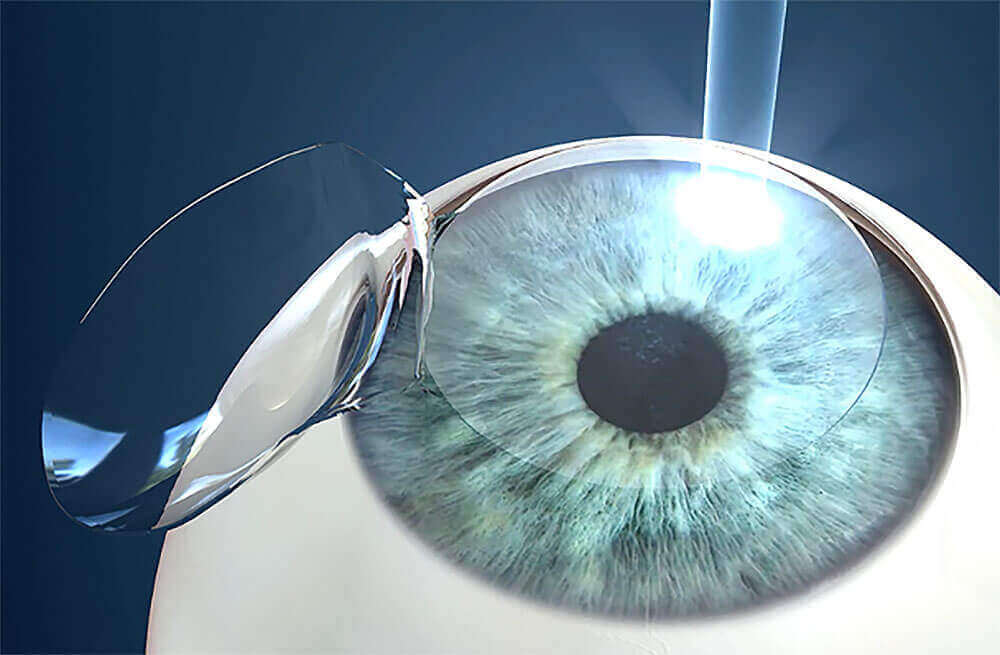
Modern LASIK technology prioritizes patient safety and comfort by incorporating advanced measures and techniques throughout the surgical process. These advancements aim to minimize risks, enhance accuracy, and optimize patient experience.
Advanced Diagnostic Tools and Imaging Techniques
Precise patient selection and treatment planning are crucial for successful LASIK outcomes. Advanced diagnostic tools and imaging techniques play a vital role in this process.
- Wavefront Analysis: This technology maps the unique imperfections of a patient’s eye, providing a highly detailed and personalized treatment plan. Wavefront analysis helps to identify and correct even subtle irregularities in vision, leading to improved visual acuity and reduced glare or halos.
- Corneal Topography: This imaging technique creates a 3D map of the cornea, revealing its shape and thickness. This information helps surgeons assess the suitability of LASIK for a particular patient and determine the appropriate amount of corneal tissue to be removed.
- OCT (Optical Coherence Tomography): This non-invasive imaging technique provides high-resolution cross-sectional images of the cornea and other ocular structures. OCT helps to detect subtle corneal abnormalities, evaluate corneal thickness, and monitor the healing process after surgery.
Expanding Treatment Options
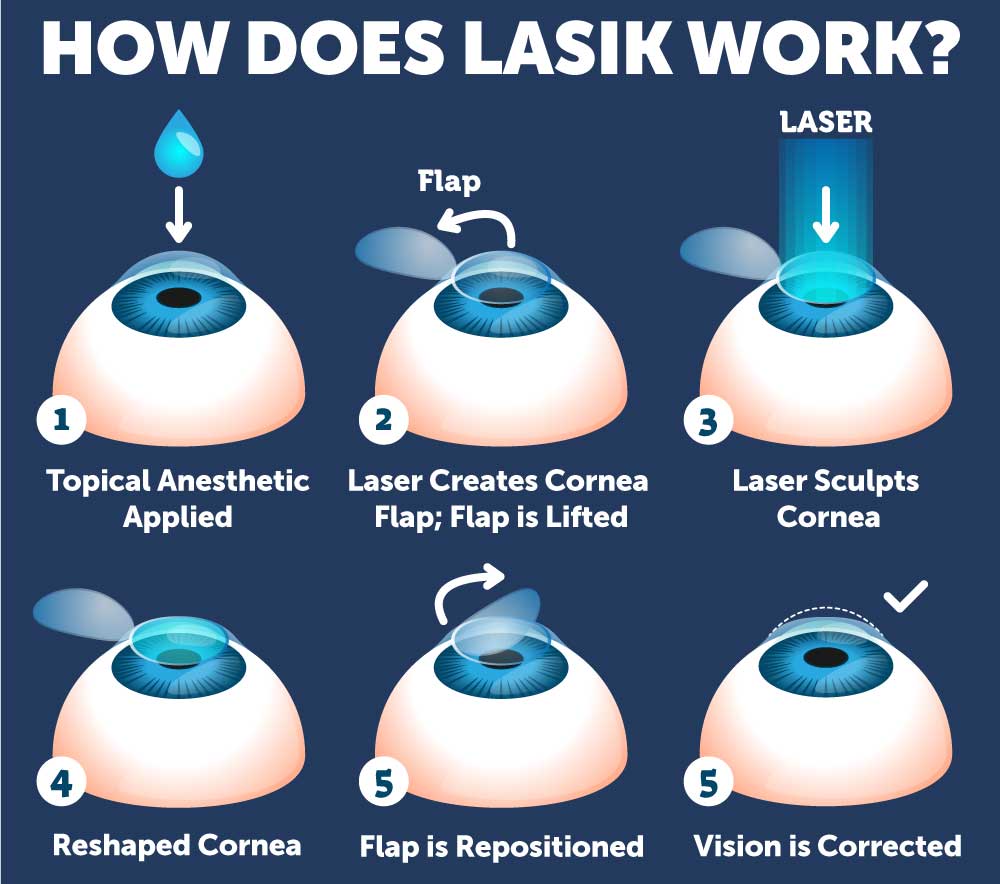
LASIK technology has evolved beyond myopia correction, offering a broader range of treatment options for various refractive errors and vision conditions.
Treating Other Refractive Errors
LASIK is now widely used to correct astigmatism, hyperopia, and presbyopia, providing a comprehensive solution for various vision needs.
- Astigmatism: This condition occurs when the cornea has an irregular shape, causing blurred vision at all distances. LASIK reshapes the cornea to correct the irregular curvature, improving visual clarity.
- Hyperopia: Also known as farsightedness, hyperopia results from a cornea that is too flat or an eye that is too short. LASIK can steepen the cornea to focus light correctly on the retina, correcting hyperopia.
- Presbyopia: This age-related condition affects the ability to focus on near objects, making it difficult to read or perform tasks requiring close vision. LASIK procedures like Monovision and Presbyopic LASIK can address presbyopia by creating different refractive powers in each eye, allowing for clear vision at both near and far distances.
Refractive Lens Exchange
For individuals with significant refractive errors or cataracts, LASIK technology has paved the way for Refractive Lens Exchange (RLE). This procedure involves replacing the natural lens of the eye with an artificial intraocular lens (IOL).
- RLE: This procedure can effectively correct refractive errors and eliminate the need for glasses or contact lenses. The IOL is implanted during surgery and provides a permanent solution for clear vision.
Corneal Cross-Linking
Corneal cross-linking (CXL) is a procedure that strengthens the cornea using ultraviolet (UV) light and riboflavin eye drops.
- CXL: This procedure is used to treat keratoconus, a condition that weakens the cornea and causes distorted vision. CXL strengthens the corneal structure, preventing further progression of the condition and improving vision.
The Future of LASIK

The future of LASIK holds exciting possibilities, driven by continuous advancements in laser technology, personalized treatment approaches, and minimally invasive techniques. These innovations promise to enhance patient safety, comfort, and visual outcomes, making LASIK an even more accessible and effective vision correction option.
Advancements in Laser Precision
The pursuit of greater precision in LASIK laser technology remains a key focus. Advancements in laser technology are leading to:
- Enhanced Spatial Resolution: Lasers with higher spatial resolution enable more precise ablation of corneal tissue, resulting in smoother corneal surfaces and improved visual outcomes. For example, femtosecond lasers are being refined to achieve even finer control over laser pulses, minimizing collateral damage and improving accuracy.
- Adaptive Optics: Adaptive optics technology compensates for eye movements and aberrations in real-time during LASIK procedures. This allows for highly personalized treatments that address individual eye characteristics, potentially leading to better visual acuity and reduced risk of complications.
- Artificial Intelligence: AI algorithms are being integrated into LASIK systems to analyze patient data, optimize treatment plans, and automate certain aspects of the procedure. This can improve efficiency and accuracy, potentially leading to more consistent and predictable outcomes.
Personalized Treatment Approaches
The trend toward personalized medicine is also influencing the evolution of LASIK. Customized treatment plans based on individual eye characteristics and lifestyle factors are becoming increasingly common. This includes:
- Wavefront-Guided LASIK: This technique uses a wavefront analysis to map the unique optical characteristics of each eye. This information is then used to guide the laser during ablation, creating a more personalized treatment that can address specific refractive errors and improve visual quality.
- Topographic-Guided LASIK: This technique uses corneal topography to create a 3D map of the cornea, which is then used to guide the laser during ablation. This approach allows for more precise treatment of irregular corneas, which can be challenging to correct with traditional LASIK methods.
- Customizable Flap Creation: Advancements in femtosecond lasers allow for customized flap creation based on individual corneal thickness and anatomy. This can reduce the risk of complications, such as flap-related issues, and improve patient comfort.
Minimally Invasive Techniques, New lasik technology
The desire for less invasive procedures is driving innovation in LASIK techniques. Emerging technologies are enabling:
- Micro-LASIK: This technique involves using a smaller laser beam and a thinner corneal flap, reducing the amount of tissue removed and potentially leading to faster healing and less discomfort.
- TransPRK: This technique uses a laser to ablate the corneal surface without creating a flap, minimizing the risk of flap-related complications. While TransPRK may have a slightly longer recovery period, it offers an alternative for patients who are not suitable for traditional LASIK.
- Surface Ablation Techniques: Surface ablation techniques, such as PRK and SMILE, are becoming more refined and are increasingly being considered as alternatives to traditional LASIK, particularly for patients with thinner corneas or specific refractive errors.
Impact of Emerging Technologies
Emerging technologies like artificial intelligence and gene editing have the potential to revolutionize LASIK surgery. These technologies could lead to:
- AI-Powered Precision: AI algorithms could analyze patient data, predict outcomes, and personalize treatment plans with unprecedented accuracy. This could lead to more effective and predictable results, potentially reducing the need for retreatment.
- Gene Editing for Corneal Regeneration: Gene editing technologies could potentially be used to repair damaged corneal tissue or even regenerate new corneal tissue, offering hope for patients with severe corneal disease or refractive errors that are not suitable for traditional LASIK.
Benefits and Limitations of LASIK Technologies
| Technology | Benefits | Limitations |
|---|---|---|
| Traditional LASIK | – Highly effective in correcting refractive errors. – Relatively quick procedure with a short recovery time. – Excellent visual outcomes for most patients. |
– Not suitable for all patients, particularly those with thin corneas or certain eye conditions. – Potential for complications, such as flap-related issues or dry eye. |
| Wavefront-Guided LASIK | – Highly personalized treatment based on individual eye characteristics. – Potential for improved visual quality and reduced risk of complications. |
– More expensive than traditional LASIK. – May not be necessary for all patients. |
| Topographic-Guided LASIK | – More precise treatment for irregular corneas. – Potential for improved visual outcomes for patients with corneal irregularities. |
– May not be suitable for all patients with irregular corneas. – More expensive than traditional LASIK. |
| Micro-LASIK | – Less invasive procedure with potentially faster healing and less discomfort. – May be suitable for patients with thinner corneas. |
– May not be as effective as traditional LASIK for certain refractive errors. – More expensive than traditional LASIK. |
| TransPRK | – No flap creation, reducing the risk of flap-related complications. – May be suitable for patients who are not suitable for traditional LASIK. |
– Longer recovery period than LASIK. – Potential for more discomfort during recovery. |
| Surface Ablation Techniques (PRK, SMILE) | – Alternative for patients with thinner corneas or specific refractive errors. – May offer a more predictable outcome for certain patients. |
– Longer recovery period than LASIK. – Potential for more discomfort during recovery. |
| AI-Powered LASIK | – Increased precision and accuracy in treatment planning. – Potential for more consistent and predictable outcomes. |
– Still under development and not widely available. – Potential for ethical concerns regarding data privacy and algorithmic bias. |
| Gene Editing for Corneal Regeneration | – Potential for repairing damaged corneal tissue or regenerating new tissue. – Could offer hope for patients with severe corneal disease or refractive errors not suitable for traditional LASIK. |
– Still in early stages of research and not yet clinically available. – Potential for ethical concerns regarding genetic modification. |
Closing Summary
The future of LASIK technology holds immense promise, with continued advancements in laser precision, personalized treatment, and minimally invasive techniques poised to further revolutionize vision correction. As technology continues to evolve, the potential for LASIK to address a wider range of vision conditions and enhance the quality of life for millions of people worldwide is truly exciting.
New LASIK technology is constantly evolving, offering patients clearer vision and faster recovery times. But just like any advanced technology, it requires expert care and maintenance. That’s where a technology handyman can come in handy, ensuring your LASIK equipment is in top condition and ready to deliver the best possible results.
With a skilled tech professional on your side, you can focus on the exciting possibilities of improved vision and a brighter future.

